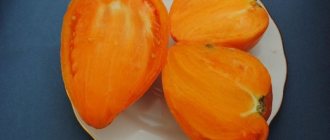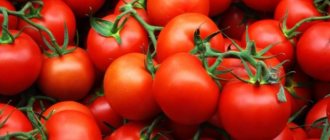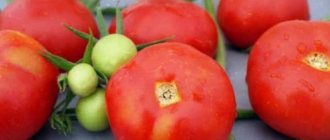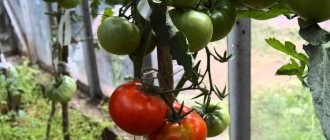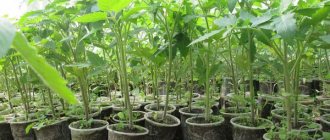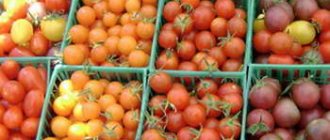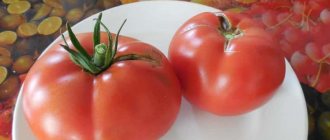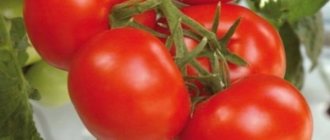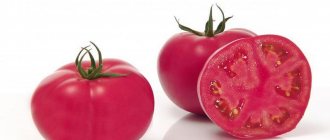You can safely start your journey through the land of tomatoes with Master Garden F1. The giant hybrid is an exhibition winner. Originally comes from Europe. It is distinguished by unpretentiousness, productivity, marketability and presentability of the fruit.
| Height | Landing location | Ripening time | Fruit color | Fruit size | Origin | Fruit shape |
| Medium height | Greenhouse, Open ground | Mid-season | Reds | Large | Hybrid | Flat-round |
The best varieties of tomatoes for 2021: photos and descriptions
When choosing tomatoes for their plot, gardeners, first of all, rely on varietal or hybrid characteristics. Productivity is the most important criterion on which the quantity and quality of the harvest depends. Sometimes it can be difficult to choose the right option from the rich variety of tomatoes for open ground and greenhouses. Then varieties are selected depending on the growing region, ripening period, degree of disease resistance and other factors.
Varieties for open ground
A huge number of species with excellent yields are intended for growing vegetables in the open air. Low-growing bushes with large fruits are one of the advantages of tomatoes for the soil. Such heat-loving plants are easier to care for and do not require complex agricultural practices.
According to ripening period
Tomatoes, like other vegetable crops, are characterized by different ripening periods, from early to late.
| Ripening period | Ripening of fruits after the appearance of the first shoots | general characteristics | The most productive tomatoes (2020) |
| Ultra-early ripening | On day 80-85 | The fruits are small, juicy, and low in sugar. The height of the bush is no more than 50 cm. Not suitable for preservation. | Little Red Riding Hood, Pride of Russia, Benito, Superstar, Valentina, Marisha, Maksimka |
| Early ripening | For 90-95 days | Small, delicate fruits, average yield. Suitable for canning and salads. Bushes grow up to 70 cm | Agatha, Riddle, Augustine, Lyana, Sanka, Buyan, Lakomka, Amur standard, Grandmother's kiss |
| Mid-early | On days 100-103 | The fruits are juicy, small, aromatic. The purpose is universal. Bush shape - compact | Openwork, Babushkino, Pulka, Red Giant, Russian Soul, Cardinal, Flamingo |
| Mid-season | On day 100-115 | High taste, excellent yield. There are both low-growing and tall varieties | Scarlet Candles, Hybrid Basket, Stresa, Intuition, Black Baron, Pudovik, Pink Honey |
| Late ripening | On day 120-130 | Excellent fruit taste, high yield, universal purpose. Good keeping quality and transportability of fruits | Giraffe, Cosmonaut Volkov, Titan, Rio Grande, Russian size, King of Kings, Rocket, Premier |
The ripening time, color and shape of tomatoes depends on the variety.
Usually early-ripening vegetables with not large fruits and not a large harvest, but with a quick, friendly yield of ripe tomatoes. Mid-season ones also have medium sizes. Late ones are usually difficult to care for, but it is among them that you can find champions in weight, but there are not many such beauties on the bush.
By growing region
Every year, breeders create new species with high quality indicators. In stores you can buy specialized varieties of tomatoes designed for growing in certain climatic conditions. Classification by regions of Russia:
- for the Moscow region: Champion, Sweet Bunch, Honey, Pink Elephant, Fireworks, Bull's forehead;
- for the southern regions: Torch, Novice, Titan, Winner, Bison, Ermak, Gift, Mikado;
- for the middle zone: Bull's Heart, Black Prince, Uzbek (Yusupov), Moskvichka, Snowdrop, Big Brother, Spasskaya Tower;
- for Siberia: Siberian heavyweight, Ultra early ripening, Sanka, Abakan pink;
- for the Urals: Coin, Bull's Heart, Button, Countryman, Yellow Buyan, Bullfinch, Demidov;
- for the far north: Snowy Tale, Ballerina, Ladyfingers, Berdsky Large, Countryman, Oak, Gina.
An unpredictable, cold or, conversely, excessively warm climate is not a reason to refuse to grow tomatoes in open ground. Thanks to selection, varieties have been developed that grow and develop well in any terrain.
According to disease resistance
To obtain a rich harvest, you need to choose tomato varieties not only with the appropriate characteristics. It is necessary that this criterion be supplemented by such an indicator as disease resistance.
Late blight, root rot, tobacco mosaic, cladosporiosis are diseases that most often affect plantings of heat-loving crops.
A catalog of tomatoes that can withstand the onslaught of various diseases:
- Blitz;
- Koenigsberg;
- Geisha;
- Betta,
- Anyuta;
- Bohemia;
- Chio-chio-san;
- Tatiana;
- Puzata hut;
- Lights of Moscow;
- Yablonka Russia;
- Crimson giant.
Unfortunately, there are no varieties that are 100% resistant to infections. But there are hybrids that produce a harvest until the active phase of many fungal diseases and infections begins.
Growing conditions
On the bag of seeds, the manufacturer indicates the possible yield. But to obtain it, you should follow the advice of agronomists. Breeders recommend:
- grow in seedlings (sow no earlier than late March-early April);
- be sure to pick with depth to the first true leaves;
- feed the seedlings with a mineral complex (once every 10 days);
- plant in a greenhouse at the age of 40 days (in cold weather, delay planting in an unheated greenhouse);
- the plant requires garter and moderate pinching;
- The Master should lead in one stem;
- the plant responds well to the addition of organic matter (the first step when planting is on the leaves);
- When planting in a permanent place, it is recommended to mix the soil in the hole with a mineral complex;
- Planting should be done according to the following scheme: the distance between plants is 40 cm, between rows - 60 cm;
- provide moderate watering.
Tomato Master
Description and characteristics of tomato Master F1, reviews, photos
Mid-season (111-115 days from germination to the beginning of ripening), tall, indeterminate tomato hybrid. Recommended for growing in greenhouses.
The bush is medium branched, medium leafy, 1.5-1.8 meters high, requires tying to a support and pinching. The plant is formed into one stem by transferring the growth point to a side shoot (stepchild). The leaves of this tomato are medium sized and dark green. The inflorescence is intermediate. The first inflorescence is laid above the 8-9 leaf, the subsequent ones - every 1-2 leaves.
Basic qualities of fruits
The fruits are round in shape, rich red in color at maturity, weighing 150-180 grams, fleshy, good (for a hybrid) taste. If you allow them to fully ripen on the bush, then these tomatoes are quite suitable for fresh consumption. If you pick them green for ripening, the taste leaves much to be desired.
Advantages of the hybrid : high yield and shelf life (up to 1.5 months) of fruits.
Planting pattern : 40 x 60 cm, planting density: 3-4 plants per 1 sq. m.
The hybrid is resistant to pathogens of tobacco mosaic virus, cladosporiosis, and fusarium.
Tomato Master F1 is included in the State Register for the 3rd light zone for growing in winter-spring rotation.
Originator and producer of seeds : agricultural company Gavrish.
If you grew Master tomatoes, please write what the yield and taste of the fruit were in your climatic conditions? Will you grow them again? Would you recommend them to others? Briefly describe the advantages and disadvantages of this tomato in your opinion. If possible, attach a photo of the entire bush or individual fruits you grew. Thank you!
Your reviews of the Master f1 tomato and additions to the description will help many gardeners evaluate this hybrid more objectively and decide whether it is worth planting or not.
Why do gardeners choose Master?
The hybrid was created by agro breeders. It is intended for growing indoors.
- average ripening period (from loops to first harvest 110–115 days);
- high bush size (stretches up to 1.8 m);
- medium foliage;
- bright green color of the tops;
- the first inflorescence is formed after the 8th leaf;
- further brushes - after 2-3 sheets;
- bears fruit in film, glass and plastic greenhouses;
- the plant gives a yield of up to 16 kg/m² (or up to 7 kg/bush).
The master is resistant to cladosporiosis, TMV, and fusarium. A competent gardener is able to obtain up to 92% of the yield of marketable products.
Some summer residents plant the hybrid in both unheated and heated greenhouses. In the latter case, fruiting is extended. Sweet tomatoes are on the menu until late autumn.
Description of the tomato variety Master F1, features of cultivation and care
Tomato Master F1 is popular among gardeners in problem regions. It gives excellent yields in protected soil. Summer residents appreciated the commercial qualities of the hybrid. Ripens early. Attracts the transportability of fruits. Tomatoes last a long time. They are consumed fresh, canned, and frozen.
Why do gardeners choose Master?
The hybrid was created by agro breeders. It is intended for growing indoors.
- average ripening period (from loops to first harvest 110–115 days);
- high bush size (stretches up to 1.8 m);
- medium foliage;
- bright green color of the tops;
- the first inflorescence is formed after the 8th leaf;
- further brushes - after 2-3 sheets;
- bears fruit in film, glass and plastic greenhouses;
- the plant gives a yield of up to 16 kg/m² (or up to 7 kg/bush).
The master is resistant to cladosporiosis, TMV, and fusarium. A competent gardener is able to obtain up to 92% of the yield of marketable products.
Some summer residents plant the hybrid in both unheated and heated greenhouses. In the latter case, fruiting is extended. Sweet tomatoes are on the menu until late autumn.
What attracts the Master?
The master is included in the State Register of the Russian Federation. Its successful cultivation in light zone 3 allows you to have vegetable products from winter to spring in heated greenhouses with additional lighting.
- fruits weighing up to 150 g;
- up to 6 tomatoes per brush;
- round shape, flattened at the stalk;
- the skin is dense, smooth;
- The color of the ripe fruit is bright red;
- a green tomato has a light spot at the stalk (then it disappears);
- the pulp is dense, juicy;
- taste sweet and sour;
- "tomato" aroma.
The tomatoes are securely attached to the stalk. The dense skin allows you to harvest with brushes. There are no losses during transportation. Without refrigeration, Master can be stored for up to 1.5 months.
If it is impossible to heat the greenhouse, gardeners harvest the tomatoes unripe. Green fruits ripen in the dark.
Growing conditions
On the bag of seeds, the manufacturer indicates the possible yield. But to obtain it, you should follow the advice of agronomists. Breeders recommend:
- grow in seedlings (sow no earlier than late March-early April);
- be sure to pick with depth to the first true leaves;
- feed the seedlings with a mineral complex (once every 10 days);
- plant in a greenhouse at the age of 40 days (in cold weather, delay planting in an unheated greenhouse);
- the plant requires garter and moderate pinching;
- The Master should lead in one stem;
- the plant responds well to the addition of organic matter (the first step when planting is on the leaves);
- When planting in a permanent place, it is recommended to mix the soil in the hole with a mineral complex;
- Planting should be done according to the following scheme: the distance between plants is 40 cm, between rows - 60 cm;
- provide moderate watering.
How to grow seedlings yourself
Seeds are sown in the last ten days of March. There is no need to disinfect the seed fund, since the manufacturer has already done this. After the appearance of the first shoots after 7 days, the seedlings should be fed with complex mineral fertilizers every 10 days. When 1-2 leaves appear on the seedlings, the young plants dive.
It is recommended to water the seedlings with warm water once every 4-5 days. When the young bushes are 40 days old, they need to be transplanted into a greenhouse.
If the room does not have heating, then in cold weather, transplanting seedlings is delayed for 2-3 days.
Tomato 'Master F1'
Latin name: solanum lycopersicum 'master f1'
Main genus: Tomato
| Productivity |
|
| Ripening period |
|
| Soil type |
|
| Growing method |
|
| Purpose of fruits |
|
| Disease resistance |
|
| Soil ph requirements |
|
| Life form |
|
| Shape of fruits/stems/roots and tubers/heads |
|
| Size of fruits/stems/roots and tubers/heads |
|
| Cultivation region by origin |
|
| Vitamin content |
|
| Color of fruits/roots and tubers | |
| Peel thickness |
|
| Frost resistance |
|
| Drought resistance |
|
| Decorative value |
|
| Taste of fruits |
|
| Shelter for the winter |
|
| Pest resistance |
|
| Habit |
|
| Keeping quality |
|
| Parthenocarpic |
|
| Branching pattern |
|
| Density and character of the pulp |
|
Expand all properties
Description of the plant:
Tomato 'Master F1' is a hybrid bred by Agrofirm Gavrish LLC. Approved for use in the 3rd light zone in 1999.
Recommended for growing in winter-spring rotation. The hybrid is characterized by its suitability for harvesting with brushes.
Dimensions and growth form:
The hybrid 'Master F1' is represented by determinate plants. The foliage and branching are moderate. Medium sized leaf, dark green.
The inflorescence is intermediate. The first inflorescence is formed above the 8-9th leaf, the subsequent ones - after 1-2 leaves.
Fruit:
Size, shape and color:
The fruits are flat-round, dense, with an average weight of 102–118 g. The surface is smooth, glossy. The color of the unripe fruit is light green, the mature one is red. Number of slots 4 or more.
The taste of the fruit is excellent.
Ripening time and yield:
Tomato 'Master F1' is an early ripening hybrid (early ripening). Fruit ripening occurs on the 101–112th day after full germination. Productivity is 13.8–15.7 kg/m2.
Keeping quality:
The crop has a high keeping quality.
Disease resistance:
The hybrid is resistant to tobacco mosaic virus, fusarium and cladosporiosis.
What attracts the Master?
The master is included in the State Register of the Russian Federation. Its successful cultivation in light zone 3 allows you to have vegetable products from winter to spring in heated greenhouses with additional lighting.
- fruits weighing up to 150 g;
- up to 6 tomatoes per brush;
- round shape, flattened at the stalk;
- the skin is dense, smooth;
- The color of the ripe fruit is bright red;
- a green tomato has a light spot at the stalk (then it disappears);
- the pulp is dense, juicy;
- taste sweet and sour;
- "tomato" aroma.
The tomatoes are securely attached to the stalk. The dense skin allows you to harvest with brushes. There are no losses during transportation. Without refrigeration, Master can be stored for up to 1.5 months.
If it is impossible to heat the greenhouse, gardeners harvest the tomatoes unripe. Green fruits ripen in the dark.
Excellent yields and beautiful appearance - tomato Master F1: description of the variety and characteristics
Tomato Master F1 has good taste for a hybrid and high yield. It has universal use, thanks to which the harvest is enough for any culinary experiments and winter preparations.
| Height | Landing location | Ripening time | Fruit color | Fruit size | Origin | Fruit shape |
| Tall | Greenhouse | Mid-season | Reds | Average | Hybrid | Round |
Description and characteristics of the variety
Tomato Master F1 is an indeterminate plant, the stems of which grow up to 180 cm. It has medium foliage and has an average number of branches. Throw out the first brush above the 8th sheet, the subsequent ones every 2-3 sheets. Inflorescences of intermediate type. Tomatoes ripen 110-115 days after seed germination. The fruits are round in shape and bright red in color, the skin is very dense and not prone to cracking. The weight of one fruit is 150-180 g. They are used for fresh consumption, packing in jars and barrel pickling, preparing lecho and cuts, juices, pastes.
Advantages and disadvantages
- good taste;
- good presentation;
- long shelf life and possibility of transportation;
- high productivity;
- immunity to diseases.
Minuses:
- There are practically no disadvantages.
Productivity
From 1 bush you get about 7 kg of fruit.
Features of cultivation and storage
The hybrid is intended for greenhouse cultivation. Bushes are pruned in the standard way - leaving the main stem and 1 side stem. The stems are tied to a support.
The harvested crop can be stored for about one and a half months without spoiling.
Description of the variety
The characteristics and description of the Master tomato are as follows:
- Fruiting of the plant occurs 110-115 days after planting the seedlings in the ground.
- The height of the bush reaches 170-180 cm. An average number of leaves are formed on the stems, painted in bright tones of green.
- The first inflorescence develops after the appearance of the 8th leaf, and subsequent clusters are formed every 2 or 3 leaves.
- Growing Master tomatoes is recommended in film, plastic or glass-covered greenhouse blocks.
- Up to 6 fruits are formed on each brush.
- The shape of the fruit is similar to a sphere, flattened in the area of the stalk. Ripe tomatoes weigh up to 0.15 kg and are colored in bright shades of red. Tomato skin has increased density. An unripe fruit has a green color, and in the area of the stalk you can see a spot that disappears as the fruit ripens.
Reviews from farmers involved in breeding the described variety show that the Master’s yield is 14-16 kg/m². Experienced vegetable growers receive up to 6-7 kg of fruit from each bush. Vegetable growers note the Master’s immunity to fusarium, cladosporiosis, and tobacco mosaic virus. Some farmers manage to obtain stable tomato yields with a yield of up to 93% of marketable products when growing the hybrid in greenhouses without heating.

